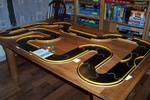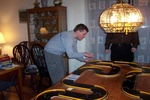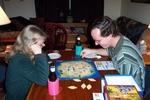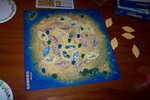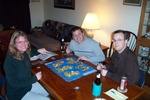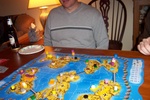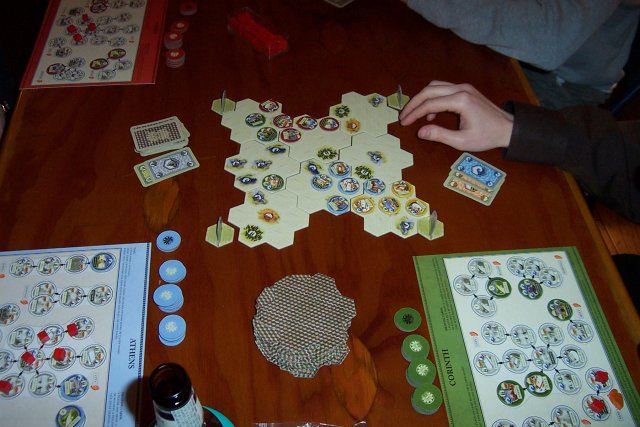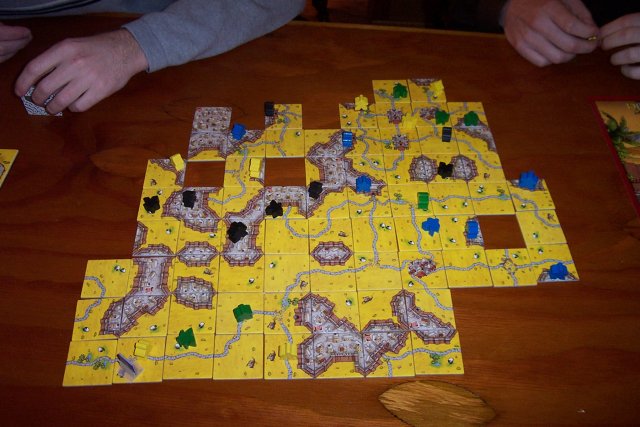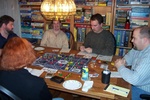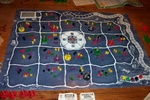
February 3, 2004Session Report for January 29, 2004by Susan Rozmiarek I had two goals tonight. The first one was to play at least one meaty game as lately it seems Iíve been playing a lot of fluff. Good fluff, but Iíve been feeling the need to exercise my brain a bit more. My second goal was to play at least one game with Mike, who was complaining that he is usually only in the footnotes of my game reports, since I only write up the games that I play. Fortunately, achieving one goal made it easy to achieve the other, as Mike tends to avoid the fluff. I had two goals tonight. The first one was to play at least one meaty game as lately it seems Iíve been playing a lot of fluff. Good fluff, but Iíve been feeling the need to exercise my brain a bit more. My second goal was to play at least one game with Mike, who was complaining that he is usually only in the footnotes of my game reports, since I only write up the games that I play. Fortunately, achieving one goal made it easy to achieve the other, as Mike tends to avoid the fluff.
CarabandeWe recently purchased a new, enormous dining room table that can seat a whopping ten people when fully extended. Iíve wanted one for a while, and I was finally able to get Ed on my side, lured by the possibilities of being able to set up really big Carabande courses. And indeed it worked very well for that purpose, even without the extra leaves. It immediately sucked in nearly every male gamer as they came through the front door and a very loud game was soon in progress. Iím not sure about the details of the game, but it must have been exciting. Did I mention how loud they were?Results: Ed in first, followed by Kevin, Doug, Mike and Jon
Bonobo BeachFortunately, like me, Mark shuns flicking games and was more than happy to play a two-player game while waiting for the others to burn off some testosterone. We chose one of his new games, Bonobo Beach.Bonobo Beach is interesting because it also comes in another edition, published simultaneously but with a medieval theme, called Cronberg. Iíd actually played it awhile back because it started out as a free game one could download and print. Itís a tile-laying game that reminds me quite a bit of Auf Heller und Pfennig. In the beach version, players are trying to control the most desirable spots on the beach. They do so by placing their tokens on these spots. The tiles have values on them, both negative and positive, and once tiles surround a marker, it is removed and the spot is scored. Whatís unique about this game and sets it apart from others is the shape of the tiles. The tiles are rhombs and the board is made up of triangles with the beach spots located in the center of the hexagons formed by six triangles (this is hard to describe Ė see photo). When a tile is placed, it will cover two of these triangles. What makes this even more interesting is the fact that triangles can be isolated so that they cannot be covered by a tile. When this happens, the triangles become ďactivated,Ē and affect the beach spots bordering them. There are three types of these triangles, toilets that drive away player tokens without scoring, dunes that multiple the value of a spot by two, and sun shades that convert the negative numbers to positive. With the last two, player tokens remain on those spots until they are scored at the end of the game. On a playerís turn he may either place a token or draw and place a facedown tile. This makes for interesting decisions about whether or not to commit a token to a spot too early, running the risk of being hosed by another player, who is sure to lay a negative tile there if he can. (Doesnít this sound like the markets in Auf Heller?). The game ends when no more tiles or tokens can be placed. Then spots next to activated triangles are also scored. I started out fairly well, but our game was interrupted and I found myself trying to carry on a conversation with someone else at the same time. Unfortunately, with my attention divided, I missed a couple of very choice spots, allowing Mark to grab them for big scores. He rolled right over me in points. I hope to try this again when I can give it my entire attention. I also think it will play even better with more players. Results: Mark 115, Susan 33 (ouch!!)
LogisticoWith the Carabande contest over, we broke into two groups, one heading off for a long game of Ursuppe while the rest of us sat down to a four-player game of Logistico. Iíd played this once with two-players and was most impressed. The other three players were new to the game.This game was so simple to explain, but it got off to a slow start as people analyzed the board full of goods and tried to visualize their best moves. Even with a hefty amount of starting capital, money is very tight in this game and everyone was grumbling about slim profit margins right from the start. There was also some complaining about going later in the turn order and not getting the lucky, easy first deliveries, but I think (hope) by the end of the game everyone realized that early deliveries were not the game-winning ones. It also took awhile for people to see how to put their airplanes to good use. It takes more planning to use them effectively. This plays a bit differently with four players than with two. With the deliveries spread out amongst more players, the scores were much lower. Heck, I was thrilled to just get back to my starting amount. With the added competition, there was also more frustration as somebody else beating you to a particular resource often ruined careful planning. I kind of like this added tension, but I think it would be too much with five players. I find most puzzle games very satisfying and rewarding to play, and Logistico definitely falls into this category. Results: Mike 45, Susan 41, Mark 39, Doug 35
AttikaNext up was the game creating more buzzing than a beehive on the gaming forums. We are all still fairly inexperienced with the game and this playing ended up being over very quickly. Doug got within a tile away from connecting two temples, thereby focusing everyoneís attention on stopping him. While this was going on, I was lucky enough to collect three street tiles on my player board. It looked like Doug was going to win on his turn, but I was able to build a building on one of those available connecting spots while Mike was able to build on the other, stopping Doug. However, nobody had noticed that I was three tiles away from connecting my chain to a temple at the other end and I had three streets in my possession. Much to everyoneís surprise and chagrin, I completed my chain on my very next turn for the win. Thank you Doug, for being an unintentional decoy. Iím quite positive that nobody will let that happen again!Results: Susan in first, followed by Mark/Mike/Doug
The Ark of the CovenantThe primordial soup was still flourishing on the other table, so we decided to try yet another version of Carcassonne, The Ark of the Covenant. Just how many of these are theoretically possible? I was hesitant to try yet another, being burned out on the whole lot of them, but Iím glad they insisted. This may be the best version of the game yet, fixing a few things and adding new twists.The first annoyance from the original that AotC fixes is the monasteries. In the original game, these simply boiled down to who was lucky enough to draw them. In this new version they are now called temples. Not only are they now worth a maximum of seven points, the owner is not necessarily the player lucky enough to draw it and park a meeple on it. The person who has the most followers (meeples) on the four tiles orthogonally adjacent to and including the temple tile controls the temple. The temple scores when the last of these tiles is placed. Other elements completed from the tile being placed are scored first and their followers removed like always. So, in this way you can steal the majority from another player. The second fix involves the Big Meeple from the expansion. He counts as two meeples and it annoys the heck out of me when somebody steals a majority from me with this big fellow. Well, in AotC, he is now the Prophet (we dubbed him Moses). Instead of counting as two followers, he simply earns his owner double points for the city if it is finished and he has the majority. So, if his owner shares the majority with another player, the other player still gets normal points. A definite improvement, I think, removing the sting a bit. The Prophet did cause big swings in points in our game. Getting your prophet in a valuable city and finishing it looks to be very important. Like Hunter and Gatherers, AotC has simple farmer scoring with none of the confusion of the original game. These are fields with flocks of sheep that count two points each for the controlling shepherd, and wolves that eat one sheep. The Ark is a totally new twist. If a player doesnít place a follower on his turn, he may move the Ark up to five tiles, with each follower passed getting a point for its owner. This is rather a nice mechanism that mitigates some of the bad luck of useless tile draws and/or having all your followers stuck on the board. It also brings up decisions on whether or not to try and clump your followers together or spread them out. Iím looking forward to trying different strategies with this. Anyhow, I did okay, but not great in this game. I did get the satisfaction of stealing a temple from Doug, although I had to share the points with Mark. I think we scored each sheep incorrectly as one point instead of two, which would have probably added about ten points to my score. Results: Mark 96, Doug 90, Susan 67, Mike 54
For more pictures from this gaming session and others, see our Gaming Picture Gallery. Posted by Susan Rozmiarek at February 3, 2004 11:02 AMThis page viewed E-mail Ed Rozmiarek with questions or problems concerning this page. Copyright © 2004, Ed & Susan Rozmiarek. |
